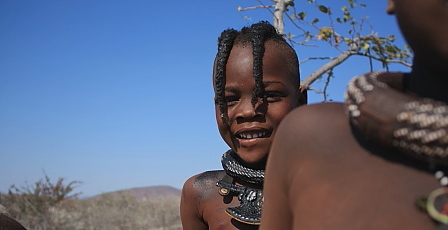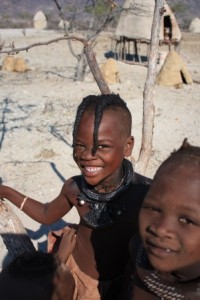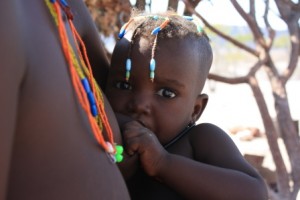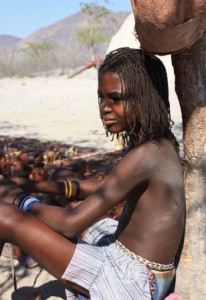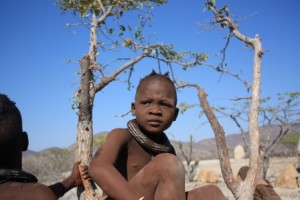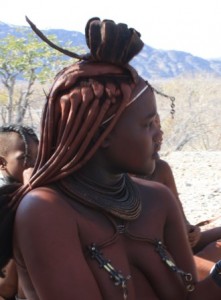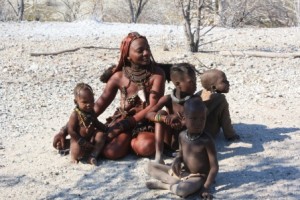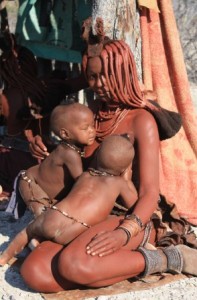Heading up to north-west Namibia, the Kunene River and the Angola border, we drive through the fabulously remote regions of Damaraland and Kaokoland. This is an extremely sparsely populated part of Africa. We’re looking forward to some ‘far-from-the-crowd’ solitude but the main attraction for us up here is to try to visit the Himba people. Such visits are not without controversy and we hesitate as to whether it is the right thing to disturb these ancient and primitive communities who have chosen to keep themselves apart from the modern world to date. Well… we want to do the drive up to the Kunene anyway, so we’ll reassess the situation regarding visiting the Himbas when we get there.
Desolation Valley
North of Swakopmund we cruise the Skeleton Coast and turn inland past the Mesum Crater. We spend over a week bumbling very slowly through the extremely scenic Damaraland countryside. I say ‘very’ slowly… there are few roads out here. We follow the dry Aub riverbed, across the vast Desolation Valley and then along the dry Huab riverbed. We covered only a few miles each day, finding different and beautiful camp-spots each night with stunning views.
We follow rough tracks established by previous 4×4 travellers and recorded by the ‘Tracks for Africa’ (‘T4A’) maps. The routes vary between very rocky, rough tracks, to deep soft sand in dry riverbeds and short but very steep climbs into and out of the dry riverbeds. The conditions allow an average speed of no more than around 10 mph, but we aren’t in a hurry! Our trusty truck, Cuthbert is ideally designed to cope with these conditions, although in places it was a struggle, even with his low ratio gears and 3 diff-locks engaged.
It’s rough and remote out here, but plenty of native wildlife survives. Damaraland is one of the few areas left in Africa where black rhinos still roam, but sadly due to hunting they are extremely rare and we didn’t see any. There are lions too, but the only evidence we saw of those were some fresh paw-prints in the sand outside our truck one morning! We did however see desert elephants, roaming zebra, giraffe, oryx, ostrich, wild cat, meerkat, springbok and duikers; not a bad little selection, bearing in mind this is no game reserve, just the rough African countryside!
Epupa – is a Fall just a Fall?
One of the marvellous things about slow overland travel is that we never know quite where our next night’s camp spot will be and what kind of scenery we will be enjoying as we relax with our cold beer at sunset. As we left the dry riverbeds of Damaraland and headed up into Kaokoland. In most of the region there is absolutely no infrastructure whatsoever: no graded roads, no electricity, no phone signals, no mains water, no schools, no medical centres, and certainly no fuel stations or food shops for anyone who is daft enough to venture up there without a very long-range vehicle capability and self-sufficiency. But if you’ve got the kit, there’s a special reward.
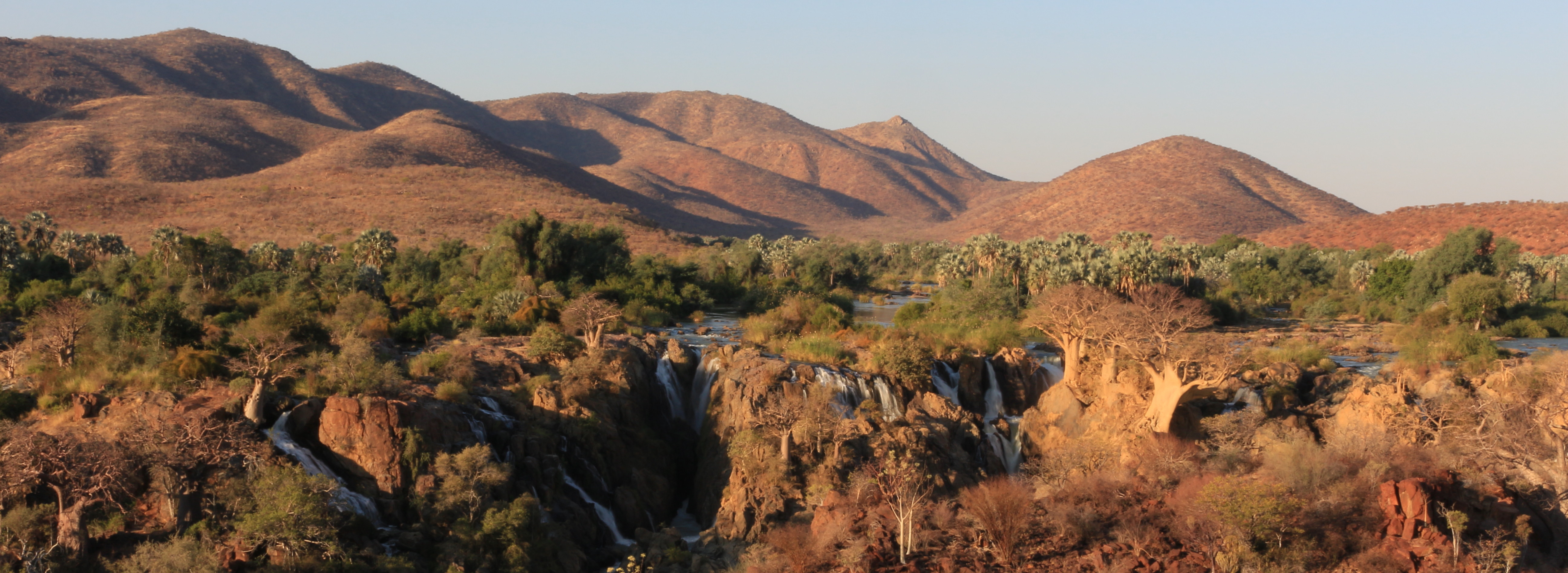
Epupa Falls sits at the very north of Kaokoland, on the Kunene River between Namibia and Angola. Long-term overland travellers often become ‘water-fall weary’ over the years. Most waterfalls are attractive and local tourism authorities all over the world are proud to sell them as attractions for visitors, but when all is said and done… ‘falling water’ is ‘falling water’. Not so in the case of Epupa. I challenge even the most waterfall weary traveller not to be entranced by Epupa Falls at dusk. The water tumbles randomly around scattered boulders and the sun sets into a glowing orange sky. But the ‘icing on the cake’ (so to speak) is the scattering of baobab trees growing at haphazard angles out of the rocks around the Falls, throwing shadows across the rocks and gushing water.
There is a magical feel to this place that I have totally failed to capture in the photos. Epupa claims no records in terms of height, width, waterflow, whatever, but it’s no exaggeration to say that Epupa is one of the most attractive and spell-binding water-falls… anywhere.
Around the Epupa Falls area, the sparse population lives in a scattering of villages of Himba tribes-people. They live the primitive existence that hasn’t been seen in most parts of the world for hundreds of years. We’ve heard that it’s possible to visit the Himba people and learn about their rare existence, but should we????
The Himba Dilemma
Even by standards of the rest of Africa, the Himba’s type of traditional existence is rare. As of 2014, thanks to the remoteness and lack of infrastructure, tourism is not yet sufficiently developed in the region to generate the ubiquitous ‘coach excursion to a traditional local craft village’ found other parts of Africa. But things are changing fast. The trickle of overlanding 4×4 tourism that is now edging into their territory, is starting to create a conflict for the Himba.
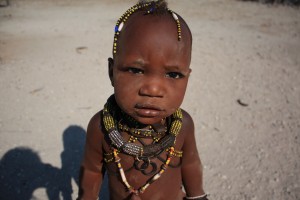
On the one hand, it seems that they don’t mind outsiders coming to see their beautiful land and are happy to engage with visitors to a limited extent. But on the other hand, they’re proud of their culture, nervous of technology (including cameras) and are understandably reluctant to become the subjects of a ‘human safari’. The Himba are traders and are happy to sell beads, and rough carvings that they have made themselves; but they do not seem to be attempting to unduly ‘cash in’ on the embryonic tourist industry that is emerging around them. The responsible traveller will therefore try to find a way of learning about and enjoying both the region and the people, contributing to their limited local economy, but not insulting their sensitivities or gawping at them through a camera lens.
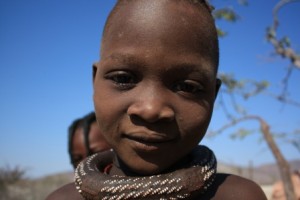 The current prevailing practice of the emerging local tourism encourages visitors to find a young Himba chap who has been to school, speaks some English, and can act as host for a village visit. Such chaps are not great in number and are not advertised, but the Falls campsite will usually be able to find one if requested. We were introduced to Remo. Remo explained that the ‘fee’ for visiting the village is some groceries that the villagers can share amongst themselves. He took us to buy a bag of maize meal, a bag of flour, a bag of sugar and a small bottle of cooking oil; we then drove to the village, Remo with us in our truck.
The current prevailing practice of the emerging local tourism encourages visitors to find a young Himba chap who has been to school, speaks some English, and can act as host for a village visit. Such chaps are not great in number and are not advertised, but the Falls campsite will usually be able to find one if requested. We were introduced to Remo. Remo explained that the ‘fee’ for visiting the village is some groceries that the villagers can share amongst themselves. He took us to buy a bag of maize meal, a bag of flour, a bag of sugar and a small bottle of cooking oil; we then drove to the village, Remo with us in our truck.
The term ‘village’ may be a slight exaggeration of the size of a Himba settlement; they typically consist of no more than six or seven mud huts as houses, plus a communal food store (on low stilts off the ground) and a small corral for the goats. After Remo sought permission from the senior ladies to allow us into their community, we were beckoned forward. Remo introduced us and we spent a fascinating few hours with the Himba families, with Remo translating and explaining the culture and traditions for us.
We were encouraged to take photos of anything that we wanted. The youngsters clearly loved it and were posing around the place like aspiring super-models; but the ladies seemed more reluctant. Face-to-face they were charming, making lots of eye-contact as part of the communication and smiling. However, the photographic experience seemed to be something of an ordeal for them. Remo was encouraging them to pose for us, but they rarely made eye contact with the camera. We obviously did not push this point and the photos are therefore mostly of the babies and children.
The ladies took us into their homes, showed us where they cook and sleep, how they bring embers of burning mopane into the huts to keep warm at night. They explained the customs of their dress and body paintings, the hairstyles. The communities consist only of women and children for most of the year, the men take herds of goats far and wide to graze where any vegetation can be found. They return home periodically to father more children, then depart again to wander.
Kunene eastwards – a million miles away
As we leave Epupa Falls we wonder what is in store for the Himbas over the 21st Century. Will they resist or be swallowed-up by a flood of tourism? Or will they manage it successfully and integrate the new industry with their ancient lifestyle? We headed east along the Kunene we found a pleasant spot for the night with a small bar serving a wicked G&T sundowner on the deck overlooking the river. Ahhh… this is the life 😊.
We were just a few kilometres, but in reality a million miles, away from the Himba ladies and children we had met earlier in the day…
Read more of our Africa Blogs Africa Route Maps

